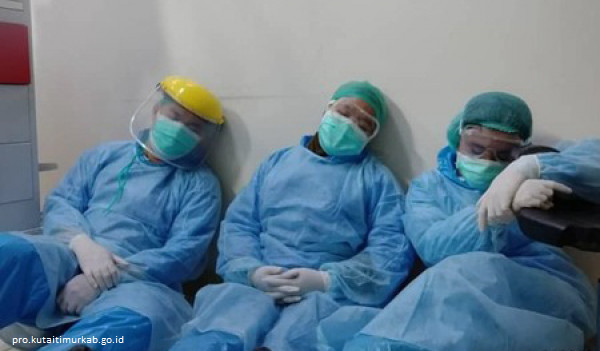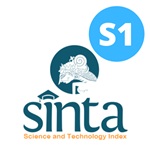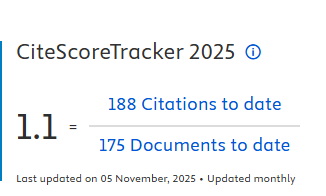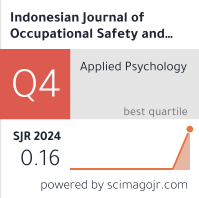The Relationship between Work Shifts and Work Environment with Nurse Fatigue in the Emergency Department

Downloads
Introduction: Work fatigue is one of the common health problems faced by nurses. Work shifts and work environment are factors that cause work fatigue for nurses. Nurse fatigue can cause work accidents and decreased work productivity. It was reported that 47% of employees experienced decreased productivity, and 32% of employees experienced injuries and near misses due to work fatigue. This research aimed to figure out whether and to what extent work shifts and work environment were correlated with nurse fatigue at the emergency department of Surabaya Haji General Hospital. Method: This analytic observational study employed a cross-sectional approach with work fatigue as the dependent variable and work shifts and work environment as independent variables. This research used the Spearman's correlation test with 30 emergency department nurses at Surabaya Haji General Hospital as the samples. The instruments used in this research were work environment questionnaires and work fatigue questionnaires from IFRC. Results: The results showed that work shift had a very weak relationship with work fatigue. At the same time, there was a moderate relationship between work environment and work fatigue. Conclusion: The work fatigue among emergency department nurses at the Surabaya Haji General Hospital observed had a very weak relationship with work shifts and a moderate relationship with their work environment.
Adhikari, P. (2015) ‘Errors and accidents in the workplaces', Sigurnost, 57(2), pp. 127–137.
Canadian Centre for Occupational Health and Safety (2017) Rotational shift-work: OSH answers.
Dewi, B. M. (2018) ‘Hubungan Antara Motivasi, Beban Kerja, Dan Lingkungan Kerja Dengan Kelelahan Kerja', The Indonesian Journal of Occupational Safety and Health, 7(1), pp. 20–29.
Duru, C. E. and Shimawua, D. (2017) ‘The Effect of Work Environment on Employee Productivity: a Study of Edo City Transport Service Benin City, Edo State Nigeria', European Journal od Business and Innovation Research, 5(5), pp. 23–39.
Febriandini, E. A., Ma'arufi, I. and Hartanti, R. I. (2016) ‘Analisis Faktor Individu , Faktor Organisasi dan Kelelahan Kerja Terhadap Stres Kerja Pada Perawat (Studi di Ruang Rawat InapKelas III RSU dr. H. Koesnadi Kabupaten Bondowoso)', e-Jurnal Pustaka Kesehatan, 4(1), pp. 175–180.
Frone, M. R. and Tidwell, M. C. O. (2015) ‘The Meaning and Measurement of Work Fatigue: Development and Evaluation of the Three-Dimensional Work Fatigue Inventory (3D-WFI)', Journal of Occupational Health Psychology, 20(3), pp. 273–288.
Hafeez, I. et al. (2019) ‘Impact of Workplace Environment on Employee Performance: Mediating Role of Employee Health', Business, Management and Education, 17(2), pp. 173–193.
Haghighi, K. S. and Yazdi, Z. (2015) ‘Fatigue Management in the Workplace', Industrial Psychiatry Journal, 24(1), pp. 12–17.
Heryana, A., Mahadewi, E. P. and Buwana, T. (2020) ‘Studi Beban Kerja Perawat IGD Puskesmas Kecamatan Kalideres Jakarta Barat Menggunakan Metode Work Sampling', Indonesian Journal of Nursing Health Science, 5(2), pp. 86–93.
Humairoh, G. P. and Putra, R. D. E. (2020) ‘Analisis Faktor-Faktor Yang Berhubungan Dengan Kelelahan Fisik Karyawan (Studi Kasus PT. X)', Jurnal Serambi Engineering, 5(3), pp. 1177–1187.
International Labour Organization (2019) Working Time Arrangements. Geneva: International Labour Organization.
Ministry of Manpower (2003) Undang-Undang Republik Indonesia No.13 Tahun 2003 tentang Ketenagakerjaan. Jakarta: Ministry of Manpower.
Kronos (2018) Wake Up to the Facts About Fatigue. United State: Kronos Incorporated.
Mallapiang, F., Alam, S. and Suyuti, A. A. (2016) ‘Faktor yang Berhubungan dengan Kelelahan Kerja Pada Perawat IGD di RSUD Haji Makassar Tahun 2014', Al-Sihah : Public Health Science Journal, 8(1), pp. 39–48.
Maulina, N. and Syafitri, L. (2019) ‘Hubungan Usia, Lama Bekerja Dan Durasi Kerja Dengan Keluhan Kelelahan Mata Pada Penjahit Sektor Usaha Informal Di Kecamatan Banda Sakti Kota Lhokseumawe Tahun 2018', AVERROUS: Jurnal Kedokteran dan Kesehatan Malikussaleh, 5(2), pp. 44–58.
National Safety Council (2018) Fatigue in Safety-Critical Industries: Impact, Risks and Recommendations.
National Safety Council (2018) Fatigue in the Workplace: Causes and Consequences of Employee Fatigue.
National Safety Council (2018) Fatigue in the Workplace: Risky Employer Practices.
Ningsih, S. N. P. and Nilamsari, N. (2018) ‘Hubungan Kelelahan Kerja dengan Produktivitas Kerja Karyawan di Fakultas Dakwah dan Komunikasi UIN Sunan Kaligaga Yogyakarta', Journal of Industrial Hygiene and Occupational Health, 3(1), pp. 69–82.
Nuraini (2018) ‘Hubungan Shift Kerja dengan Kelelahan Kerja pada Perawat di Instalasi Rawat Inap di Rumah Sakit Herna Medan Tahun 2018', Jurnal JUMANTIK, 4(1), pp. 45–56.
Oksandi, H. R. and Karbito, A. (2020) ‘Faktor-Faktor yang Berhubungan Dengan Kelelahan Kerja Pada Perawat Di RSUD dr.H.BOB Bazar Kalianda Kabupaten Lampung Selatan Hendro', Jurnal Ilmi Kesehatan Indonesia (JIKSI), 1(1), pp. 1–7.
Perez, J. F. et al. (2019) ‘Shift and Night Work Management in European Companies', Quality Access to Success, 20(169), pp. 157–165.
Rahmawati, N. D. and Tualeka, A. R. (2019) ‘Correlation between Individual Characteristics, Workload, and Noise with Work Fatigue', The Indonesian Journal of Occupational Safety and Health, 8(2), pp. 139–149.
Ratih, R. M., Mulyatini, N. and Suhendi, R. M. (2020) ‘Pengaruh Shift Kerja Terhadap Efektivitas Kerja Pegawai (Suatu Studi Pada PT. BKS (Berkat Karunia Surya) di Kota Banjar)', Business Management and Entrepreneurship Journal, 2(1), pp. 66–77.
Romadhoni, L. C., Asmony, T. and Suryatni, M. (2015) ‘Pengaruh Beban Kerja, Lingkungan Kerja, dan Dukungan Sosial Terhadap Burnout Pustakawan Di Kota Mataram', Khizanah al-Hikmah : Jurnal Ilmu Perpustakaan, Informasi, dan Kearsipan, 3(2), pp. 124–145.
Setiawan, B., Fauzan, A. and Norfai (2020) ‘Tingkat Kelelahan Kerja Pada Driver Dump Truck Ditinjau Dari Aspek Masa Kerja Dan Usia Di PT Hasnur Riung Sinergi Site PT Bhumi Rantau Energi Tahun 2019', Medical Technology and Public Health Journal, 4(2), pp. 134–145.
Setiawan, D. (2016) ‘Hubungan Antara Umur Dan Intensitas Cahaya Las Dengan Kelelahan Mata Pada Juru Las PT. X Di Kabupaten Gresik', The Indonesian Journal of Occupational Safety and Health, 5(2), pp. 142–152.
Sharma, J., Dhar, R. L. and Tyagi, A. (2016) ‘Stress as a Mediator between Work–Family Conflict and Psychological Health among the Nursing Staff: Moderating Role of Emotional Intelligence', Applied Nursing Research, 30, pp. 268–275.
Soedirman and Suma'mur (2014) Kesehatan Kerja dalam Perspektif Hiperkes dan Keselamatan Kerja. Jakarta: Erlangga.
Steege, L. M. and Rainbow, J. G. (2017) ‘Fatigue in Hospital Nurses ” "Supernurse” Culture is a Barrier to Addressing Problems: A Qualitative Interview Study', International Journal of Nursing Studies, 67, pp. 20–28.
Suma'mur (2009) Higiene Perusahaan dan Kesehatan Kerja (HIPERKES). Jakarta: Sagung Seto.
Susanti, S. and Amelia, A. R. (2019) ‘Faktor yang Berhubungan dengan Kelelahan Kerja pada Pekerja PT. Maruki International Indonesia Makassar Tahun 2018', Sinergitas Multidisiplin Ilmu Pengetahuan dan Teknologi, 2, pp. 231–237.
Susita, D., Muslimah, W. and Waspodo, A. A. (2017) ‘The Influence of Work Discipline and Work Environment on Organizational Commitment Employee of SBU Energy at PT Biro Klasifikasi Indonesia (PERSERO) North Jakarta', Jurnal Riset Manajemen Sains Indonesia (JRMSI ), 8(2), pp. 275–297.
Tarwaka and Bakri, S. H. A. (2004) Ergonomi untuk Keselamatan, Kesehatan Kerja dan Produktivitas. Surakarta: UNIBA PRESS.
Workplace Health and Safety Queensland (2020) Preventing and Managing Fatigue-Related Risk in the Workplace. Queensland: Government of Queensland.
Copyright (c) 2022 The Indonesian Journal Of Occupational Safety and Health

This work is licensed under a Creative Commons Attribution-NonCommercial-ShareAlike 4.0 International License.

In order to be accepted and published by The Indonesian Journal of Occupational Safety and Health, Author(s) who submit an article should complete all the review process. The copyright of received articles assigned to the The Indonesian Journal of Occupational Safety and Health and Department of Safety and Health, Universitas Airlangga as publishers of the journal. The intended copyright includes the rights to publish articles in various forms (including reprints).
The Editorial Team of The Indonesian Journal Of Occupational Safety and Health and Department of Safety and Health strive to ensure that no errors occur in the articles that have been published, both data errors and statements in the article.
Users of this website will be licensed to use materials from this website following the Creative Commons Attribution-NonCommercial-ShareAlike 4.0 International License. No fees charged. Please use the materials accordingly.
------------------------------------------------------------------------------------------------------------------------------------------------------------------------------------------
Attribution ” You must give appropriate credit, provide a link to the license, and indicate if changes were made. You may do so in any reasonable manner, but not in any way that suggests the licensor endorses you or your use.
NonCommercial ” You may not use the material for commercial purposes.
ShareAlike ” If you remix, transform, or build upon the material, you must distribute your contributions under the same license as the original.







 How to Submit Articles in OJS
How to Submit Articles in OJS

























